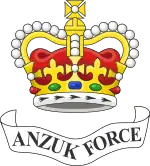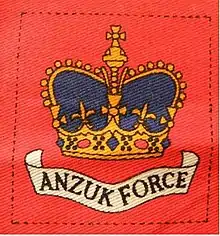ANZUK
ANZUK was a tripartite force formed by Australia, New Zealand and the United Kingdom to defend the Asian Pacific region after the United Kingdom withdrew forces from the east of Suez in the early 1970s. The ANZUK force was formed in Singapore on 1 November 1971 under Rear Admiral David Wells and disbanded in 1974.[1]
| ANZUK | |
|---|---|
 | |
| Active | 1 November 1971 – 16 December 1974 |
| Country | |
| Garrison/HQ | Singapore |
| Commanders | |
| Notable commanders |
|
| Insignia | |
| Flag of ANZUK |  |
ANZUK order of battle
ANZUK initially consisted of the following major units:
ANZUK Force HQ
- 9 ANZUK Signal Regiment: Under command of the Royal Australian Corps of Signals, 9th (ANZUK) Signal Regiment task was to support the ANZUK Force, which in 1970 had replaced the British Forces Headquarters and Installations in Singapore. this joint service, multi national regiment took over, as going concerns, the Royal Navy Transmitter Stations at Suara, and the Royal Navy Receiver Station Kranji. The regiment employed New Zealand and British Army, Navy and Air Force Personnel together with locally enlisted Singaporean, British, New Zealand and Australian civilian technicians and communication specialists. In addition there was operational control of a group of Malaysian Navy communicators, which were to interface the force with the Malaysian Navy.[2]
- ANZUK Traffic Management Agency (ATMA)[3]
- ANZUK Intelligence and Security Unit[4]
- 65 Ground Liaison Section
- ANZUK Provost Unit[5]
Naval component
- Two RN frigates
- RAN Frigate
- RNZN Frigate
- RN or RAN submarine
Land Component
The land component of ANZUK Force was essentially the units of 28th Commonwealth Infantry Brigade Group renamed and relocated from Malaysia to Singapore.
28th ANZUK Brigade
Brigade Commanders of 28 ANZUK Brigade were:[6]
- Brigadier Michael Walsh[7] 1971–1972
- Brigadier Michael Kennedy[8] 1972–1974
Units that constituted 28 ANZUK Brigade were:
- 28 (ANZUK) Brigade HQ and Signal Squadron
- 6th Battalion, Royal Australian Regiment,[9] Kangaw Barracks
- 1st Battalion Royal New Zealand Infantry Regiment,[10] Dieppe Barracks
- 1st Battalion Royal Highland Fusiliers,[11] Meerut Barracks[12]
- 28th ANZUK Field Regiment,
- Combined Australian/British HQ Battery
- 1st Battery Royal Artillery "The Blazers"
- 106th Field Battery, Royal Australian Artillery[13]
- 161 Battery Royal New Zealand Artillery[14] (1972 only)
- 28 ANZUK Field Squadron[15]
- 28 ANZUK Aviation Squadron
- 182 Reconnaissance Flight AAAC (two helicopters),
- No. 656 Squadron AAC (one flight): Was the RE Air Troop, moved and rebadged from Jungle Warfare School, Kotatingi, Johore
Transport Element
Ordnance Element
- ANZUK Ordnance Depot:[20][21] To support the Land Army component of the ANZUK Force, the ANZUK Ordnance Depot was established from the existing Australian/New Zealand 5 Advanced Ordnance Depot. Located in the premises vacated by the Royal Navy Victualling Depot on the dockside at Sembawang Naval Base. Ordnance support to ANZUK Force was based upon an integrated supply service manned by service personnel from the RAOC, RAAOC and RNZAOC with locally employed civilians (LEC) performing the basic clerical, warehousing and driving tasks. ANZUK Ordnance Depot was constituted of the following elements:
- Stores Sub Depot
- Vehicle Sub Depot
- Ammunition Sub Depot
- Barrack Services Unit
Workshop Element
- ANZUK Area Workshops, Kangaw Barracks
Air Component
Dress distinctions
Contributing nations wore their individual national uniforms with the addition of the following identifying patches;
- ANZUK Headquarters and Support elements:
 HQ ANZUK and Support Units patch
HQ ANZUK and Support Units patch - 28 ANZUK Brigade Units:
 28 ANZUK Brigade Patch
28 ANZUK Brigade Patch
Sea and Air components did not wear any of the patchs as they remained under national command and were only attached to ANZUK command on an as required basis.
Disbandment
By 1973 the political climate in Australia and the United Kingdom had changed and it was time for ANZUK to be disbanded. Rear Admiral Wells,[22] the First ANZUK commander who established the Force, had the task of planning the run-down phase and handing over to his successor Air Vice Marshal Richard Gordon Wakeford,[23] to follow through.
Australia would be retaining a presence in Butterworth in Malaysia[24] and the United Kingdom had decided to withdrawal all its forces east of Suez.[25][26] It was in New Zealand's interest to retain a force in southeast Asia, so on 30 January 1974 New Zealand Force South East Asia was formed,[27] taking under its command all the New Zealand units formerly part of ANZUK.
Over the course of 1974 the integrated units which made up the ANZUK were gradually disbanded and replaced by national units. On 16 December 1974 the Naval and Air Headquarters were disbanded and their assets reverted to their respective national command and what remained of the United Kingdom's land component forces became the 28th (UK) Infantry Brigade.
Taking several years for the Australian and United Kingdom units to draw down and withdraw, it was not until 1977 that NZFORSEA was the sole remaining foreign presence in Singapore.
References
- "Digger History". Retrieved 1 September 2016.
- Lord, Cliff; Lord, Chris; Watson, Graham (2014). Royal Corps of Signals: Unit Histories of the Corps (1920–2001) and Its Antecedents. Helion & Company Limited. p. 383. ISBN 978-1874622925.
- "Integrated Eastern defence" (PDF). flightglobal.com. FLIGHT International, 9 March 1972. Retrieved 6 September 2016.
- Van der Bijl, Nicholas (2013). Sharing the Secret: the History of the Intelligence Corps 1940–2010. Pen & Sword Military. p. 252. ISBN 9781848844131.
- "28th Commonwealth Infantry Brigade Provost Unit Malaya, Borneo & Singapore". Retrieved 2 September 2016.
- Eaton, H. B. (Hamish B.) (1993). Something extra: 28 Commonwealth Brigade, 1951 to 1974. Edinburgh: Pentland. ISBN 1858210496. OCLC 29468672.
- "Major-General Michael J H Walsh, CB, CBE, DSO". paradata.org.uk. Retrieved 6 September 2016.
- "Michael Ralph Kennedy". aucklandmuseum.com. Retrieved 6 September 2016.
- "Battalion History". 6rarassociation.com. Retrieved 6 September 2016.
- "1 RNZIR". Digger History. Retrieved 6 September 2016.
- "1st Bn The Royal Highland Fusiliers 1959–2006". rhf.org.uk/. Archived from the original on 13 September 2016. Retrieved 31 August 2016.
- "Royal Highland Fusiliers". British Army units from 1945. Retrieved 6 September 2016.
- "The Forgotten Regiment 28 ANZUK Field Regiment". The Royal Australian Artillery Historical Company. Retrieved 31 August 2016.
- "161 Battery Unofficial History". iwvpa.net/. Retrieved 31 August 2016.
- "Destination Malaya – the History Book of 2 Field Troop (1963–1965)" (PDF). wasappers.com. Archived from the original (PDF) on 28 February 2016. Retrieved 6 September 2016.
- Lindsay, Neville (1991). Equal to the Task – The Royal Australian Army Service Corps. Historia Productions. ISBN 9780646067063.
- Anzuk Force. (1974). History of Anzuk Base Transport Unit, June 1971 – June 1974. Singapore : Base Transport Unit, Anzuk Force.
- "he History of 90 TRANSPORT PLATOON, RAASC". remlr.com. Retrieved 6 September 2016.
- "112 S and T Coy RAASC – Singapore". RAASC Digest: 95–96. 1971.
- Steer, Brigadier Frank (2005). To The Warrior His Arms: History of the RAOC. 1844153290. p. 211.
- "ANZUK ORDNANCE DEPOT 1971-1975". "To the Warrior His Arms" History of the Royal New Zealand Army Ordnance Corps and Its Predecessors. Retrieved 5 September 2017.
- "Rear Admiral David Charles Wells". navy.gov.au. Retrieved 2 September 2016.
- "Air of Authority – A History of RAF Organisation: Air Marshal Sir Richard Wakeford". rafweb. Retrieved 2 September 2016.
- Radcliffe, Mathew (2015). Kampong Australia : the colonial reckonings of the Australian military community in Penang, 1955–1988. Australia Macquarie University.
- Pham., P.L. "Ending 'East of Suez': The British Decision to Withdraw from Malaysia and Singapore, 1964–1968". oxfordjournals. Retrieved 2 September 2016.
- Dockrill, s (2002). Britain's Retreat from East of Suez. London: Palgrave Macmillan UK. ISBN 9781349407033.
- McGibbon, Ian (2000). The Oxford Companion of New Zealand Military History. Oxford. p. 369. ISBN 0195583760.